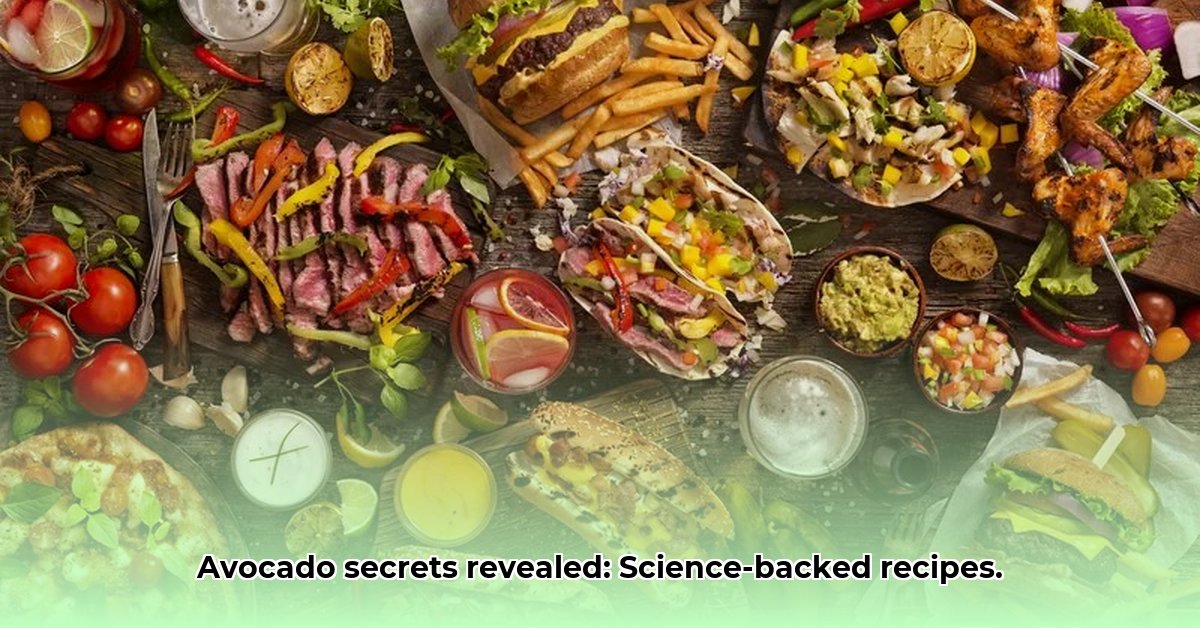Avocados: they’re more than just yummy guacamole! This guide dives into the science behind this amazing fruit, exploring its nutritional benefits, different types, and how to use them in tons of delicious ways. We’ll uncover the secrets to perfectly ripe avocados, making the most of avocado oil, and share some amazing recipes—plus, we’ll explain why they work so well. Get ready to become an avocado expert and take your cooking to the next level! For more on avocado’s impact on blood sugar, check out this helpful guide on avocado glycemic index.
Food That Starts With Av: Unveiling the Avocado’s Culinary Secrets
Avocados – those creamy, green gems – are so much more than just the star of guacamole. They’re incredibly versatile, fitting right into sweet treats or savory dishes with equal ease. But how much do you really know about this amazing fruit? Let’s peel back the layers and discover the avocado’s hidden depths, including exploring avocado benefits and culinary applications.
Avocado: A Nutritional Powerhouse
Let’s start with the good stuff: nutrition. Avocados are bursting with healthy fats, mostly the monounsaturated kind that are good for your heart. They’re also packed with fiber, keeping you feeling full and satisfied, plus a bunch of essential vitamins and minerals like potassium, folate, and vitamin K. Think of them as nature’s superfood, a creamy, delicious way to boost your health. But what’s the difference between all those different avocados you see at the store, and how does this impact avocado nutrition?
That’s where things get interesting. There are tons of avocado varieties out there, each with its own unique taste and texture. The familiar Hass avocado, with its bumpy skin, is just one player in a much bigger game. Some varieties have a smooth, buttery texture, while others offer a slightly nutty flavor, and even hints of sweetness. We’re still learning about the exact nutritional differences between all these varieties–it’s an ongoing area of research. For example, some studies suggest that certain cultivars have higher antioxidant levels than others. This means there’s plenty of exciting discoveries to be made in the avocado world. Are you ready to explore the less common types, and understand avocado cultivars?
- Avocados are rich in monounsaturated fats, promoting heart health.
- They are also an excellent source of dietary fiber, aiding digestion and satiety.
- Ongoing research is illuminating nutritional nuances among different avocado varieties.
- Avocados contain vitamins K, C, B5, B6, E, potassium, and folate.
Culinary Applications: Beyond the Guac
Guacamole is undeniably delicious, but let’s venture beyond the basics. Avocados are incredibly adaptable in the kitchen. Picture them sliced on toast, diced into salads, or blended into a rich, creamy soup. They’re a staple in many Latin American dishes, but they also shine in modern fusion food. This fruit can be used in everything from smoothies to desserts. Are you looking for an innovative way to add avocado flavor pairings to your dishes?
Let’s explore some culinary adventures:
- Breakfast: Start your day with the creamy indulgence of avocado toast. A sprinkle of salt, pepper, and maybe some chili flakes or everything bagel seasoning turns this simple dish into a culinary masterpiece. You can add a poached egg on top for extra protein.
- Lunch: Slice avocados into sandwiches or layer them into salads for a healthy dose of creaminess and flavor. Pair them with grilled chicken or chickpeas for a filling and nutritious meal.
- Dinner: Use them as a base for luscious sauces or roast them and add them to hearty stews for a boost of richness and texture, enriching the avocado texture profiles. Try blending avocado into a pesto for a unique twist on pasta night.
- Snacks: Even a simple avocado and tomato salad is a refreshingly delicious treat. It’s that easy! Add a squeeze of lime juice and a sprinkle of cilantro for extra zest.
And don’t forget avocado oil! This healthy oil offers a subtle, fruity flavor that elevates dishes, plus it’s great for high-heat cooking due to its high smoke point, opening up exciting realms for avocado oil uses. Drizzle it over roasted vegetables, use it in marinades, or bake with it for added moisture and flavor.
Exploring the World of Less Common Avocado Varieties
Most of us are only familiar with the Hass avocado. However, a whole world of other delicious avocado varieties is waiting to be discovered! These include Fuerte, Reed, Bacon, Zutano, Pinkerton, and Gwen, each offering unique tastes and textures. Just imagine the culinary possibilities if chefs started using these lesser-known varieties in their dishes. This is where innovation truly thrives. We need more research to understand the full potential of these amazing fruits, and chances are, there are exciting new flavors and textures out there just waiting for us to discover them, impacting avocado consumption trends.
The Future of Avocado in Food Science
What’s the next chapter in the avocado’s story? Researchers are working on creating exciting new hybrids, developing improved farming techniques, and conducting in-depth nutritional analysis. Scientists are also exploring ways to extend the shelf life of avocados and reduce food waste. Creating standardized nutritional databases for all the commercially available avocado varieties is a big goal for scientists. This will help us better understand the health benefits of different types, allowing us to better refine avocado based recipes. Our avocado journey is just beginning! The culinary and scientific exploration of this amazing fruit has enormous potential. We’re just scratching the surface.
Avocado Varieties: A Quick Peek (More Research Needed!)
| Variety | Texture | Flavor Notes | Common Uses | Best Season |
|---|---|---|---|---|
| Hass | Creamy | Nutty, buttery | Guacamole, toast, salads | Year-round |
| Fuerte | Smooth | Mild, slightly sweet | Salads, smoothies, desserts | Fall to Spring |
| Bacon | Buttery smooth | Rich, slightly peppery | Slices, dips, various desserts | Fall to Winter |
| Reed | Smooth, firm | Mild, buttery | Salads, sandwiches | Summer |
| Zutano | Light | Mild, subtle | Dips, spreads | Fall |
| Pinkerton | Creamy, rich | Slightly nutty | Guacamole, spreads, salads | Winter to Spring |
| Gwen | Rich, Creamy | Nutty, buttery | Toast, salads, sandwiches | Late Spring to Early Summer |
| (Note: A complete nutritional comparison across all varieties needs more research.) |
The world of avocados is full of delicious surprises, and we’ve only just begun to explore its many possibilities. As consumers, we can ask for more information about the different varieties. As scientists and chefs continue to work, they will undoubtedly unlock even more of the secrets held within this versatile fruit. Let’s enjoy this delicious journey of discovery together! How does the future look for avocado industry insights?
How to Compare Nutritional Values of Different Avocado Varieties
Key Takeaways:
- Avocado nutritional profiles vary significantly by variety and growing region.
- Fat content is a key differentiator, with California Hass avocados often showing higher levels than Florida varieties.
- Other nutrients like Vitamin K and potassium also differ between types.
- Consider both weight and nutrient density when comparing varieties, emphasizing avocado research studies.
- How to compare nutritional values of different avocado varieties effectively involves reviewing and comparing data from multiple reliable sources, while considering variations in testing methodologies and growing conditions.
Understanding Avocado Diversity
Avocados aren’t one-size-fits-all. Dozens of varieties exist, each boasting unique flavor profiles and textures. But what about their nutritional content? Are there significant differences, and how do these differences impact dietary fats? Absolutely! Let’s dive in.
Nutritional Variability: A Deeper Look
While all avocados pack a nutritional punch, significant variations exist in their macro and micronutrient compositions. This isn’t just about the amount of fat; it’s about the balance of fats, carbohydrates, proteins, vitamins, and minerals. For example, Hass avocados, a popular choice, tend to be higher in fat than some other varieties. But are they superior in overall nutritional value? Not necessarily. It depends on your needs, emphasizing macronutrient analysis.
The Importance of Fat Content
Fat content is often a key criterion when comparing avocados. This is not always due to a healthy fats perspective, some people are simply looking to use a creamier variety for different purposes. California-grown Hass avocados often boast impressively higher fat content than their Florida counterparts, but this difference isn’t universally consistent across all studies. Why the variation? Several factors, including growing conditions, soil composition, and the avocado’s maturity stage at harvest, all play a role, explaining regional avocado variations. Different growing regions can result to different levels of fat content.
Beyond Fat: Other Nutritional Factors
Don’t focus solely on fat. Vitamins and minerals matter too! Some varieties are richer in Vitamin K, others boast higher potassium levels. These variations influence the overall health benefits. For example, Reed avocados sometimes show higher Vitamin K concentrations compared to Hass. Fuerte avocados may exhibit different potassium levels. However, further research is needed to establish these trends conclusively, emphasizing the need for micronutrient comparisons.
**
- Shop Bento Box for Sale To Find Your Ideal Lunch Container - December 6, 2025
- Lunch Box That Fits Bento Box Neatly for Daily Use - December 5, 2025
- Japanese Lunch Bag Does Double Duty as Bento Carrier and Tote - December 4, 2025










